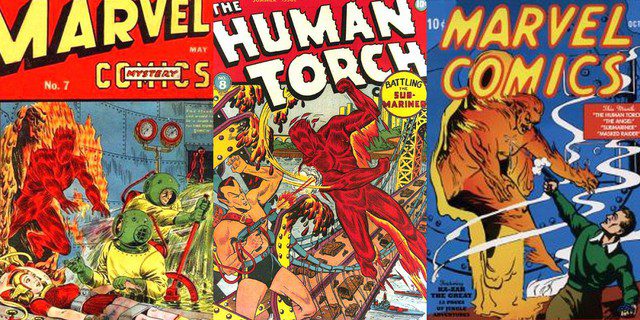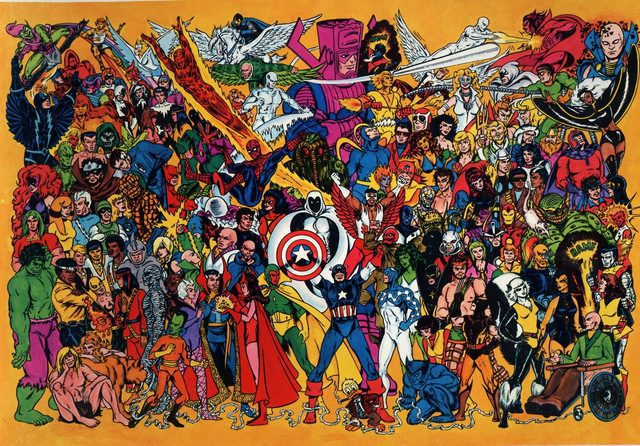Marvel Comics is a comic book series published by Marvel Entertainment, Inc. The name Marvel is closely associated with popular characters such as Fantastic Four, The Amazing Spider-Man, The Incredible Hulk, Iron Man, Daredevil, Thor, Captain America, and X-Men. Almost all fictional characters of Marvel are developed within a unique comic universe known as the Marvel Universe.
Since the 1960s, Marvel has been one of the two largest comic book companies in the U.S., alongside DC Comics, which has created a rivalry between the two in the comic book industry today. From its origins as Timely Comics (1939) to the present, the company has always maintained its headquarters at the McGraw-Hill building, located on Madison Avenue in New York City. In this article, we will explore the history and development of Marvel Comics to this day:
Timely Comics
Marvel Comics was founded by a well-known publisher – Martin Goodman in 1939 as a subsidiary of Timely Comics. The first publication was Marvel Comics #1 (October 1939), featuring the debut of the Human Torch – an android superhero created by Carl Burgos, alongside the “submarine soldier” Namor the Sub-Mariner. Marvel Comics #1 was a huge success, though it was still under the pseudonym Funnies, Inc., until a year later when Timely established itself in this publishing venture.
The first editor of the company, writer Joe Simon, collaborated with legend Jack Kirby to create the first iconic superhero in comics – Captain America in Captain America Comics #1 (March 1941), which quickly became a phenomenon.
Besides the “big three,” no other characters from Timely gained much popularity; only a few superheroes like Whizzer, Miss America, The Destroyer, Vision (the original), and Angel (Paul Gustavon) made appearances (albeit minor) in current comics.
Atlas Comics (1950s)
In the post-World War II era, the comic book business experienced a significant decline due to the emergence of superhero comics, leading to a “dark age.” Similar to other comic companies, Timely – often referred to as Atlas Comics in the 1950s – had to adapt by publishing a variety of genres, including horror, westerns, romance, war, and science fiction. Some products were successful, but many also faced considerable failures. Between 1953 and 1954, the company launched a “resurrection” campaign for superheroes with the “big three” Human Torch, Namor the Sub-Mariner, and Captain America, but the results did not meet expectations.
From 1952 to the end of 1956, Goodman distributed comics to Atlas’s newsstands – the company’s main distributor. After that, he switched to the American News Company, the largest distributor and nearly the sole source in the U.S. at that time – however, not long after, it went bankrupt and had to cease operations.
The final comic products to feature the Atlas logo were Dippy Duck #1, the only publication from the company released in October 1957. Shortly thereafter, the first products under the “Marvel Comics” brand were launched – Amazing Adventures #3, a science fiction comic series that debuted on May 9, 1961.
The 1960s
In the late 1950s to the early 1960s, while DC Comics was enjoying success with the revival of superheroes through The Justice League of America, Marvel decided to make a comeback in the game.
In November 1961, The Fantastic Four #1 was published, marking a significant milestone in Marvel’s development history, introducing a new superhero style. Editor/writer Stan Lee and artist Jack Kirby created the Fantastic Four, so it was not surprising that this superhero team bore some resemblance to the earlier comic series Challengers of the Unknown, which Kirby had pitched to DC in 1957. However, here, they avoided the classic tropes of superhero identities being hidden or merely being a form of representation, instead presenting characters that were more relatable and human, with conflicts and dynamics among them. Marvel shifted towards a direction of “heroes in reality” rather than “mythical figures.”
Following this success, Marvel released a series of heroes and anti-heroes in this trend such as Hulk, Spider-Man, Thor, Ant-Man, Iron Man, X-Men, and Daredevil, as well as introducing many notable villains like Doctor Doom, Magneto, Galactus, Green Goblin, and Doctor Octopus. The key focus of Marvel was to develop deeper character personalities compared to previous comics. Notably in The Amazing Spider-Man, our teenage hero often faced issues of self-doubt, insecurity, and had to confront everyday challenges that any teenager could encounter. Marvel superheroes are often not perfect; they constantly battle personal issues, which adds depth and relatability that contrasts sharply with the flawless figures seen in traditional stories. Some Marvel heroes even appear no different from a villain or a monster. As we can see, this approach has sparked a revolution in the comic industry.
From then on, Stan Lee became one of the most recognized names in the comic world. His wit and humanistic character were reflected in each character and comic page he created. Alongside this, he excelled in building dialogues and stories, providing a “hands-on” method that blended creativity with traditional storytelling. Many even jokingly recognized him as having a “superpower” that connected him closely with his readers. Additionally, in the creative team, notable figures such as Jack Kirby contributed ideas and characters for comics like Fantastic Four and The Mighty Thor, including Watcher, Silver Surfer, and Ego the Living Planet; and Steve Ditko created very vivid environments in Spider-Man and the “mystical realm” in Dr. Strange.
In 1968, founder Martin Goodman sold Marvel Comics and its other publishing assets to Perfect Film & Chemical Corporation. After that, they were consolidated into a subsidiary called Magazine Management Co., while Goodman continued to serve as publisher.
The 1970s
In 1970, realizing the potential market in the UK, Marvel created a “British superhero for British people” – Captain Britain, initially published in the UK, later in the U.S.
In 1971, Marvel Comics editor Stan Lee was approached by the U.S. Department of Health, Education, and Welfare to request that he produce a comic addressing drug use. He agreed and attempted to incorporate this theme into several Spider-Man series, however, he faced censorship from the Comic Code Authority (CCA). Despite this, with Goodman’s approval, Lee published the story in The Amazing Spider-Man #96-98 (May-June 1971). The positive response from readers compelled the CCA to eventually revise its regulations the following year.
In 1972, Goodman stepped down and was succeeded by Stan Lee. Once again, the comic industry faced a downturn, and Marvel, under Stan Lee’s leadership, continued to diversify. With the latest updates from the Comic Code Authority, the company achieved significant success in genres like horror (Tomb of Dracula), martial arts (Shang-Chi: Master of Kung Fu), fantasy (Conan the Barbarian, Red Sonja), and science fiction (“Killraven” in Amazing Adventures). Some products were published in dark-colored magazines aimed at a more adult readership. Alongside this, Marvel continued to explore the philosophy of superhero genres established in the preceding decades.
In 1973, Perfect Film & Chemical Corporation rebranded itself as Cadence Industries, and Magazine Management Co. officially became Marvel Comics Group. Goodman, by this point, was no longer involved with Marvel, deciding to launch a new company – Atlas/Seaboard Comics in 1974 to revive the Atlas name; however, this venture only lasted a year.
Throughout the 1970s, Marvel was affected by the expansion of the direct market comic distribution system. However, hot properties like Howard the Duck became the direct beneficiaries of this distribution method, even as sales were generally not as high as those reported by other publishers. Fortunately, by the late 1970s, sales began to rise again, aided by direct market distribution (selling through specialty comic shops instead of newsstands).
During this period, Marvel also sought to acquire DC, though this effort ultimately failed as DC wanted to retain the rights to its two most prominent characters, Superman and Batman. Afterward, DC was absorbed into Warner Communications by the Kinney National Company, and the battle between these two “giants” continues to this day.
The 1980s
This was a pivotal time as “the man in charge” of Marvel was Jim Shooter. Jim played a significant role in improving the editorial staff before Marvel was undergoing serious changes and reviving productivity for the creative team, leading to the release of the new comic line New Universe to commemorate Marvel’s 25th anniversary (1986) and launching monumental crossover events (Contest of Champions, Secret Wars). However, he faced criticism from many who labeled him as “editorial heavy-handed” and frequently interfered in the creative processes of the writers.
In 1981, Marvel acquired the animation studio DePatie-Freleng Enterprise, renaming it Marvel Productions. This division produced a range of animated series and films, including G.I. Joe, The Transformers, Dungeons & Dragons, and Spider-Man.
In 1986, Marvel was sold to New World Entertainment, and three years later it was transferred to MacAndrews and Forbes, owned by Revlon’s chairman Ronald Perelman. Perelman began to diversify the company on the New York Stock Exchange and began rapidly increasing the number of comics Marvel published. During this process, Marvel Productions had to collaborate with its animation studio and license characters to Saban Entertainment, ultimately selling to Disney in 2001.
During the early 1990s, Marvel experienced a comic boom, launching the 2099 series set in a futuristic landscape that became quite successful (for example, Spider-Man 2099). However, by the mid-90s, the comic industry in the U.S. began to decline, and Marvel faced the threat of bankruptcy as financial operations under Perelman became scrutinized.
In 1990, Marvel started selling Marvel Universe trading cards featuring images of superheroes and created a strong fanbase in the community, leading to competitive pressure from DC as well. By 1992, Marvel acquired Fleer Corporation, primarily for card production, and not long after, it established Marvel Studios, focusing on film and TV projects. Avi Arad became the head of this division in 1993 and achieved significant milestones starting from 1998 with the success of the film Blade.





























